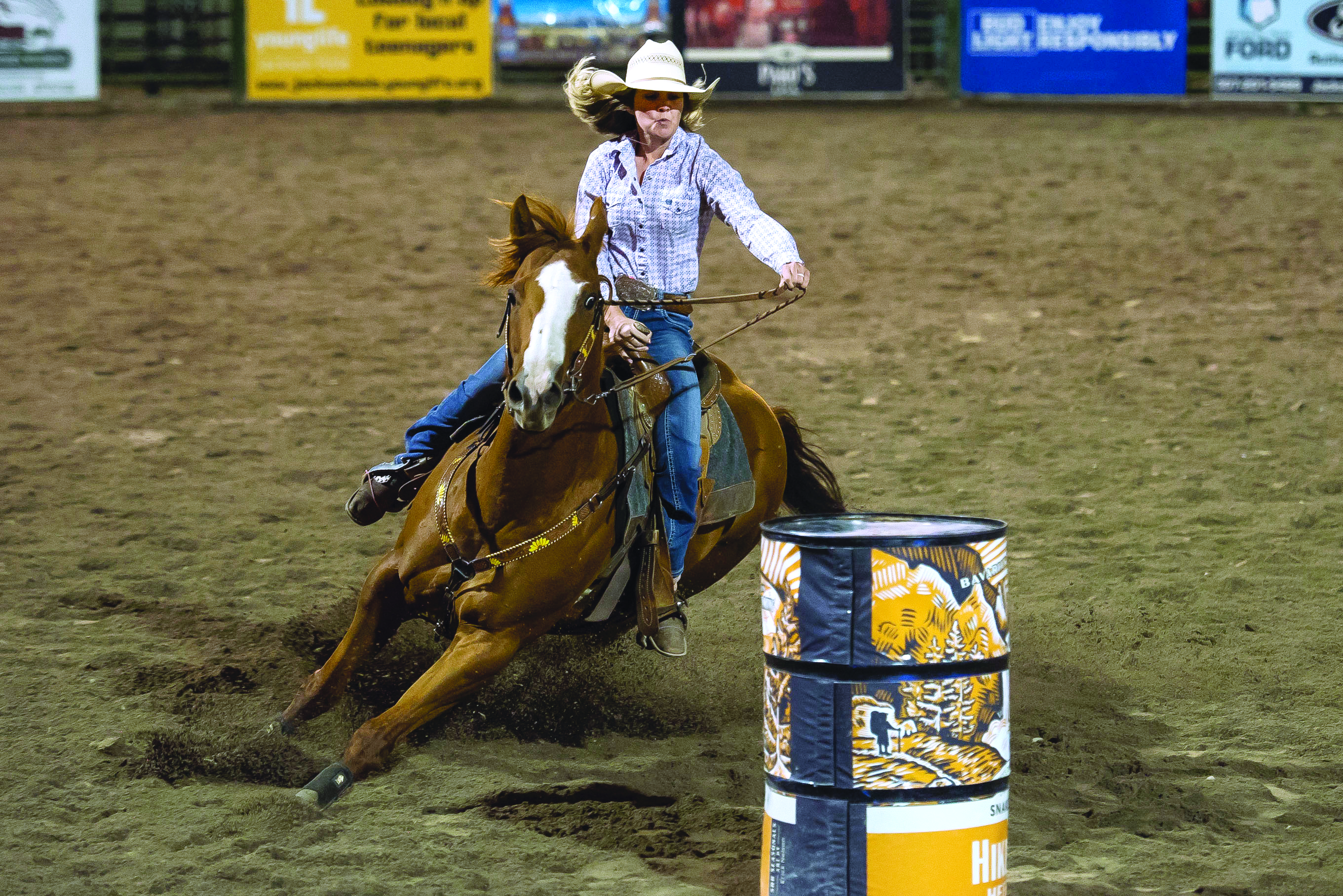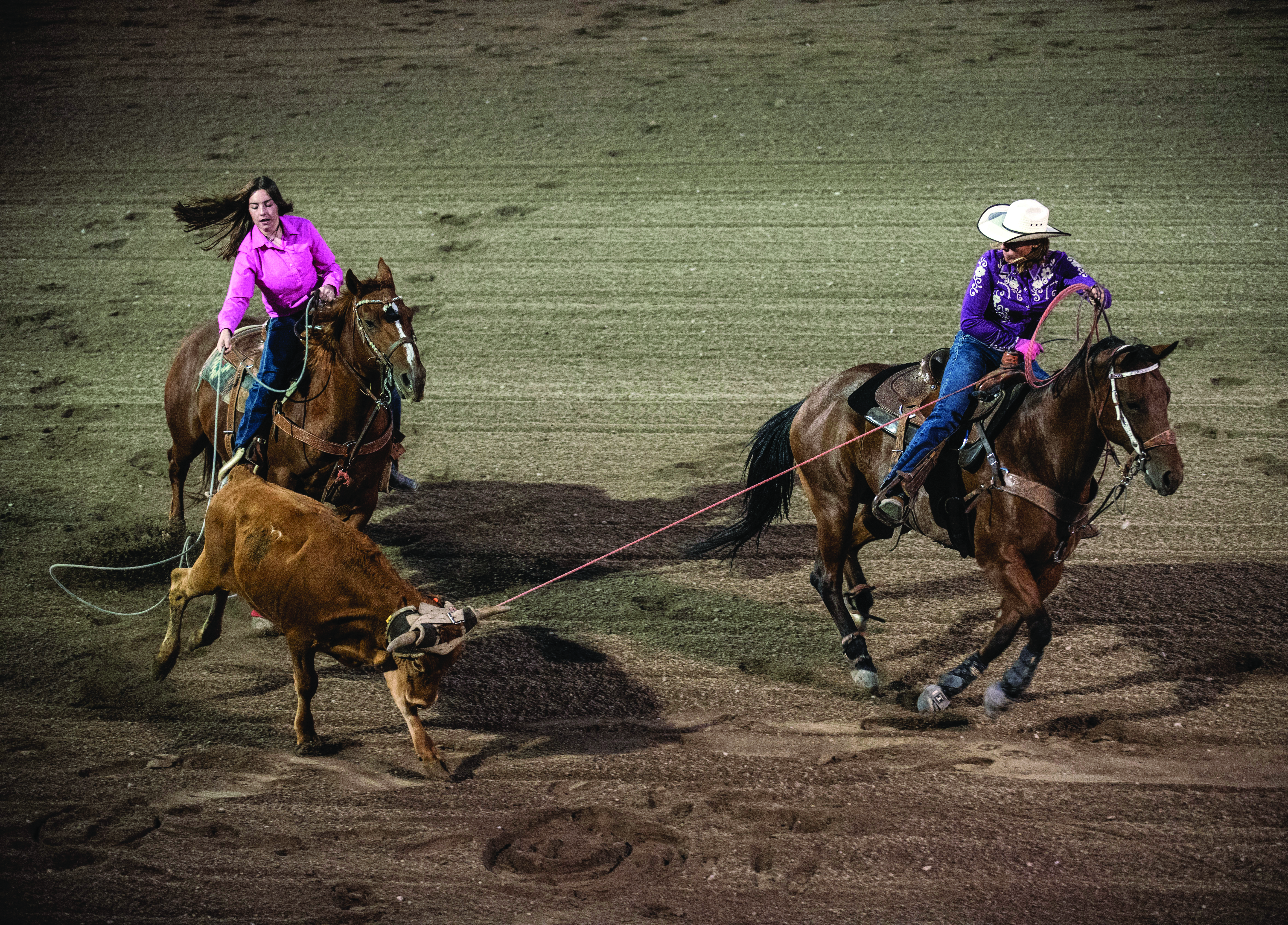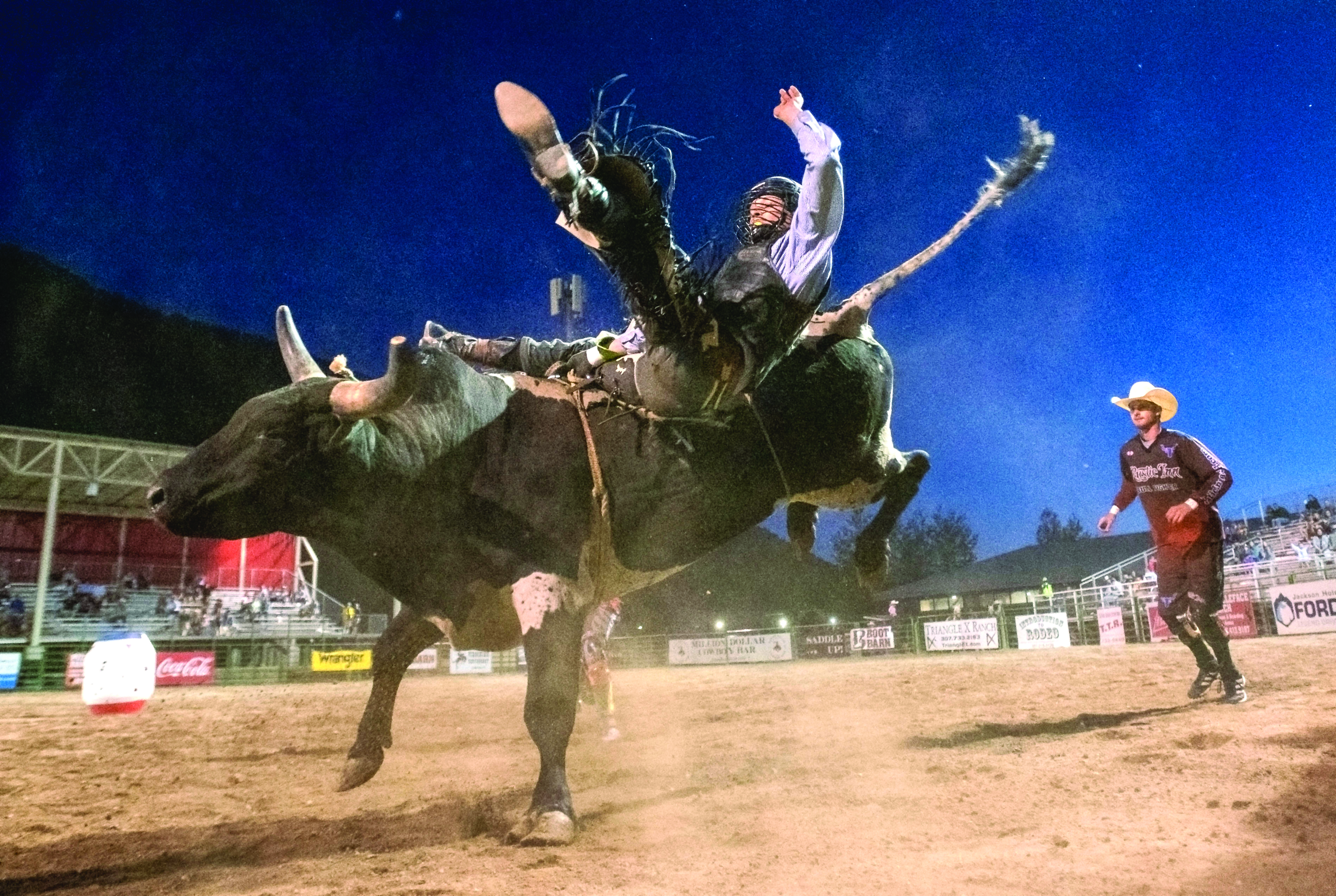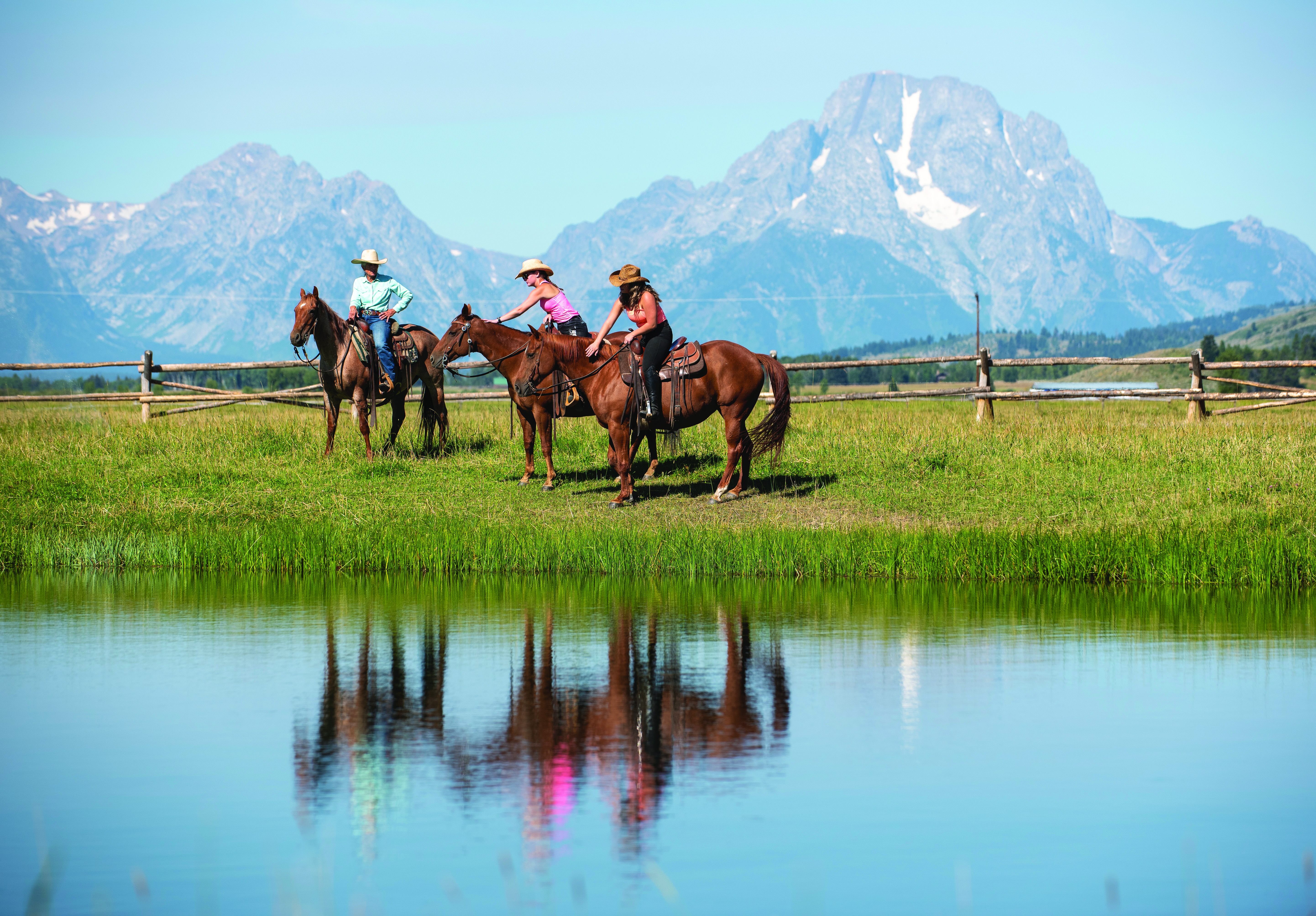Read The
Current Issue
Cowboy Up!
Get to know the different rodeo events, plus a way to play cowboy yourself.
// By Samantha Simma
Jackson Hole’s wild and Western heritage comes alive for spectators of the Jackson Hole Rodeo beneath the arena lights of the Teton County Rodeo Grounds Wednesday and Saturday evenings from Memorial Day weekend through Labor Day (with additional rodeos on Fridays during July and August). In 1890, Sylvestor Wilson accompanied settlers over Teton Pass to settle what is now Jackson Hole. Six generations later, the Jackson Hole Rodeo is a Wilson family affair. Brandon Wilson, Sylvestor’s great-great-grandson, says, “It’s the Old West—the closest you can get to the way things were.”
The location of the rodeo has changed over the years—moving from Jackson to the town of Wilson, then back to Jackson in the mid-1960s—but the spirit of competition has remained relatively unchanged: cowgirls and cowboys go boot-to-boot in a range of timed or roughstock (judged) rodeo events that include bull and bronc riding, barrel racing, and a variety of roping events.
Brandon Wilson, 49, grew up in a ranching and rodeo family at a time when Jackson had more ranches than hotels and opportunities to do rodeo were plentiful. “If you wanted to try to get on a calf, you just went to a branding,” he recalls. As Jackson has evolved, such opportunities have diminished, and rodeoing communities everywhere are aiming to increase ways for younger generations to get involved in the sport. Wilson says a goal of the Jackson Hole Rodeo is, “to provide opportunities to young people to learn and get better at the sport. People are always impressed with how involved the younger generation is, but the older generation can’t do the bull and bronc riding forever,” Wilson says. “I think we’re the only sport in the world where you root for your competitors. You want everyone to do well because it pushes you to do well.”
Between the thrill of the competition and the spirit of the Old West, the rodeo draws a following of contestants and spectators. Tickets from $33; 447 Snow King Ave.; 307/733-7927, jhrodeo.com
The only rodeo event in which men and women compete together equally, team roping allows single-gender and mixed-gender teams. Teams are of two and, together, they pursue a steer. The goal is for one rider, the header, to rope the steer’s horns—or neck, or one horn and the nose—before wrapping his or her end of the rope around their saddle horn. Next, after the head of the steer has been secured, the second rider—the heeler—ropes the steer’s hind legs. (If the heeler gets just one leg, the team is penalized.) A timed event, the watch stops when the two riders have immobilized the steer between their horses. The Wilson family still competes in the Jackson Hole Rodeo team roping event.

Bareback bronc riding is one of the most physically demanding events in rodeo and was conceived to emulate the breaking skills of a working cowboy. However, in modern times, the event is a highly stylized competition that requires riders to lean back on the bronc and spur in a specific manner that was never historically used in actual practice. The horses chosen for this event are specially bred to be strong and agile. “Riding a bronc is a ballet; it’s finesse, not muscle,” Wilson says. But, “People don’t realize how much force it is on your body. It pulls on every muscle.” Bronc riders want the horse to buck as hard as it can so it gets more points and then they, the rider, get more points. Not surprising, this event has a very high injury rate.

Barrel racing is a timed rodeo event in which a horse and rider aim to complete a cloverleaf pattern around three triangulated barrels—usually 55-gallon metal or plastic drums. The winner of this event comes down to the fastest time, and Wilson says that it can be won by one one-thousandth of a second. A rider’s time depends not only on the condition of their horse, but also on their horsemanship and the condition of the arena’s ground. Horse and rider “must know each other on a superior level,” Wilson says. “You have to communicate [with your horse]; you can’t just go fast.” While both genders compete at this event at the youth and amateur levels, barrel racing opened the gates for women in rodeo, and as such, is predominantly a women’s event at the collegiate and professional ranks.

The only rodeo event in which men and women compete together equally, team roping allows single-gender and mixed-gender teams. Teams are of two and, together, they pursue a steer. The goal is for one rider, the header, to rope the steer’s horns—or neck, or one horn and the nose—before wrapping his or her end of the rope around their saddle horn. Next, after the head of the steer has been secured, the second rider—the heeler—ropes the steer’s hind legs. (If the heeler gets just one leg, the team is penalized.) A timed event, the watch stops when the two riders have immobilized the steer between their horses. The Wilson family still competes in the Jackson Hole Rodeo team roping event.

“Bull riding has always been at the forefront of rodeos,” Wilson says. “Because of the danger.” Bulls are selected for rodeos based on their strength, health, and agility, and later judged for a ride based on its power and speed. “They’re a beast to tame in the eyes of spectators, while the riders are dragon slayers.” For their part, riders are randomly paired with a bull and then judged on their rhythm and control—but only if they remain mounted for at least eight seconds with one hand on the rope. If cowboys touch their rope, the bull, or their own body with their free hand, they are disqualified. The total score of a ride is determined by combining the bull and rider’s individual scores.
Cowboy Camp

Test out the cowboy life in a three-day camp at a historic ranch.
For five generations, the Diamond Cross Ranch family has carried on the legacy started by Fred and Caroline Feuz—immigrants from Switzerland who started one of Jackson’s first cattle ranches in Buffalo Valley, north of what is now Jackson Hole. For the second summer, it’s sharing the cowboy way of life with participants of its Cowboy Camp.
“Cowboy Camp is an authentic way to share our family’s—and Jackson Hole’s—Western heritage with people from around the world,” says Peter Long, great-grandson of the Feuzs. The hands-on immersive experience invites guests to stay at the ranch’s cabins while participating in activities including horsemanship, doctoring cattle, and range management. The camp is limited to 15 participants, and skill levels may range from experienced ranchers to novice and even first-time riders. Over the course of the three-day camp, instruction is provided by professional cowboys, and participants are paired with horses that have undergone extensive training by “horse whisperer” Grant Goliher. Including meals and lodging, the price per person starts at $2,500; 24340 Diamond Cross Rd., Moran, Wyoming; 864/354-8766, diamondcrossranch.com JH




